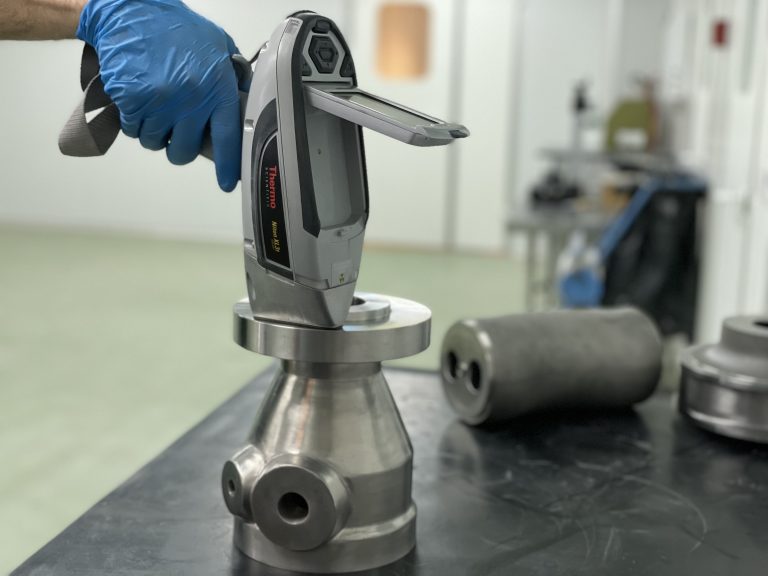Quality is one of FREEZE CAST’s core values. As a result of our strong commitment to the ongoing investment in FREEZE CAST’s human resources, processes and facilities, we still believe any investment in quality is a valuable one.
As part of this top quality approach, and whenever requested by the customer, we perform non-destructive tests on our parts. These tests do not permanently alter the physical, chemical, mechanical or dimensional properties of the parts.
At FREEZE CAST we have seven types of non-destructive testing that can be applied to your project:
Penetrant liquids
These detect possible defects on the surface of the materials, as well as surface discontinuities. This test can be performed on any solid, non-porous material. It is usually used on non-ferrous alloys, but can also be used for inspection of ferrous materials when magnetic particle inspection, which will be explained below, is difficult to apply. Metallic materials, glazed ceramics, plastics, porcelain and electrochemical coatings can be inspected with this method.
This technical test is perfectly adapted to the complicated geometries of hydraulic parts such as impellers, diffusers, pump bowls and pump bodies. This is why approximately 80% of the parts we produce are subjected to this test.
Magnetic particles
This test detects surface or subsurface defects based on the accumulation of particles of ferromagnetic material. It basically consists of magnetizing the part to be inspected, applying the magnetic particles (fine powder of iron filings) and evaluating the indications produced by the clustering of the particles at specific points. This process varies according to the materials used, the defects to be searched for and the physical conditions of the object to be inspected.
Remember that this test is only applicable if the base material is ferromagnetic, therefore it is not possible to perform it on highly alloyed stainless steels, so for a foundry specialized in stainless steels as we are, this test is not as versatile as the liquid penetrant test.
PMI
It stands for Positive Material Identification. It verifies the chemical composition of metals and alloys so that the materials supplied conform to the appropriate standards and specifications. It covers a wide range of applications in industry, such as:
- The casting of metallic materials for the manufacture of structures and equipment
- The inspection of these structures in service
- The classification of scrap metals
- The study of materials used in a possible repair
- Chemical composition in the purchase or reception of products
- Mining
- The composition of metals in paints
It is also a highly demanded test in FREEZE CAST, which guarantees that the material delivered is 100% reliable with respect to the requested standard.
If you want to know more information about our precision foundry.

Dimensional control
Using reliable measuring systems and a strategic process parameter to achieve accuracy and compliance of component dimensioning with respect to drawing and design.
At FREEZE CAST we carry out dimensional checks, from examining the dimensions of raw castings to extremely accurate checks on fully machined parts up to a few hundredths of a millimeter accuracy.
Radiographic Test
Radiographic testing (RT) uses gamma rays or X-rays to examine the internal structure of manufactured components and identify any faults or defects in them.
This radiation is more or less absorbed by the internal discontinuities of the part, reaching the other side with a different radiation intensity, and impresses a radiographic film, which, once developed, shows variations in density, being darker in the thinner area and lighter in the thicker area.
For the interpretation of the radiographic plates, the inspector must consider the indications produced on them, considering that they can be affected by other causes such as part geometry, film defects.
In this way, we are able to detect volumetric defects inside the material of the casting. It is a highly demanded test in the manufacture of prototype parts.
Ultrasound
This is a method of characterizing the thickness or internal structures of a part under test by applying high-frequency ultrasonic waves. They are used to identify the presence of possible discontinuities in the part to be inspected, both superficial and internal. They use the reflection of the acoustic waves to observe their behavior and their reflection waves. Depending on the behavior of the waves, the presence or absence of discontinuities and their exact location can be detected.
Generally, ultrasonic equipment is composed of a probe, which is an element that emits different waves to find the desired defect. There are different types of probes and they can have different angles. It also includes a couplant, which is the liquid that expands in the material in order to properly propagate the waves emitted by the probe to the part. Finally, we also have the equipment, which is the receiver and analyser of the signals received by the probe.
Due to the complex geometry of the parts that we manufacture at FREEZE CAST, this test is clearly the least demanded of all the above, as it is more suitable for simple geometries and constant thickness.
Visual Inspection (VT)
Carried out by a qualified person by direct visualization of the parts. It is important to know how to carry out the visual observation and interpret the results by comparing them with the current market standard. It is the most widely used non-destructive test in all material manufacturing industries. Its strong point is that it allows control at all stages of the manufacturing process or maintenance of facilities. This makes it possible to evaluate the acceptability in accordance with the different codes and standards in force.
If you would like to obtain your model-free casting in less than 2 weeks, please do not hesitate to contact us or call us at +34 921 49 00 96.
We will be pleased to provide you with detailed information about our production capabilities.
You may also be interested in reading:
INNOVATIVE SOLUTIONS FOR THE MINING INDUSTRY IN CHILE
MATERIAL TESTING IN FOUNDRIES: UNDERSTANDING THE PROCESS AND ITS SIGNIFICANCE (II)
DESTRUCTIVE TESTING IN FOUNDRIES: UNDERSTANDING THE PROCESS AND ITS SIGNIFICANCE (I)
